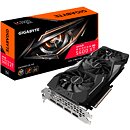Wednesday, January 22nd 2020

GIGABYTE Outs RX 5600 XT Gaming OC VBIOS Update and Easy Updater
GIGABYTE late-Tuesday released a video BIOS update for its Radeon RX 5600 XT Gaming OC graphics card (model: GV-R56XTGAMING OC-6GD). The new FA0 video BIOS increases TGP of the card to a massive 180 W (up from 150 W original spec), gaming clocks up to 1670 MHz, boost clocks up to 1750 MHz, and memory clocks up to 14 Gbps (GDDR6-effective), up from 12 Gbps. Gigabyte's BIOS update package for the RX 5600 XT Gaming OC includes a Windows-based GUI updater that's a lot easier to use than manually updating the BIOS using ATIWinFlash. Grab the update package from the link below.
DOWNLOAD: GIGABYTE RX 5600 XT Gaming OC New FA0 BIOS Update
DOWNLOAD: GIGABYTE RX 5600 XT Gaming OC New FA0 BIOS Update


30 Comments on GIGABYTE Outs RX 5600 XT Gaming OC VBIOS Update and Easy Updater
I hate signed vbioses with a passion.
The main problem for me is that AMD decided to call this "stock". It's such a weird move for a large, serious company that AMD would like to become.
Makes me wonder what AIB think about it. Some designs may not be ready to handle the extra heat. Cards are already manufactured.
Plus, AIBs surely wanted to launch some high-end variants with factory OC, which now became pointless and badly priced (like the ASUS Strix TOP).
Another example of AMD not being an easy business partner... And AMD fans complain that their favourite company doesn't get as much OEM/AIB attention as Intel or Nvidia.
As for AIB/OEMs using Nvidia GPUs - I can't recall any major problem (made public). Any example? :)
How else was AMD supposed to respond. It would have been totally different if they had reference cards for the 5600XT.
I have very limited personal experience with Intel, but Nvidia - compared to a 20-30 companies I closely worked with in academia and business - is really a gold standard.
Now, this may not be as good all over the world, because Nvidia has a very large office where I live (Warsaw, Poland) - but from what I've heard they're just as mobile and professional as Big4 or other large players.
nvidia gpp scandal was very real.
I think this could have been handled much better, even if they postponed the launch for a few days. It shouldn't be the end consumer doing something that had to come ready from AMD and AIBs. Mainly, since it is something that, although little, always has some degree of risk.
OpenCuda like most of Nvidia's tech is closed and designed to force you onto their hardware. CUDA cores suck compared to AMDs compute units, but NV tries their hardest to kill or stall OpenCL adoption because the only company that can make CUDA cores is NV, so they cripple OpenCL on their hardware, and make CUDA look so much better.
Stuffing black box code into games that devs aren't even allowed to look at. That suspiciously enhances performance for one side but causes problems for the other.
G-sync is more of the same, let's make a piece of hardware mandatory that doesn't actually improve upon frame sync tech that's built into Display Port, but few monitors actually supported both. Now they came out with gSync that le gasp uses the open standard but they still try to spin it as the gimped edition. Intel started pushing the open standard, so NV had to cave.
Look at EVGA, they literally can't even make an AMD chipset motherboard. Ever wonder why?
PhysX... Oh we can't have people getting PhysX with a Radeon or other GPU, so let's lock the drivers and kill that. RTX is the same closed source garbage, NV is sweating because the consoles will be all rocking open standard RTRT... How much is it going to cost them to buy off the devs to redo the RT coding so NV doesn't have to run it through a wrapper.
Yeah, NV is a dream to deal with if you aren't a consumer who wants choice. They'll throw money and samples at you, coddle and swaddle you, but there's a real price.
I'm sorry I should clarify they do have one GPU that can actually do FP64 than AMD... It certainly isn't affordable though...
Volta is a beast, but the cheapest version is the Titan V and it costs what $3000usd
Titan V $2,999 USD 7.45Tflops FP64
Radeon VII $699 USD 3.36Tflops FP64
Ok we'll add in the special kid...
2080 Ti $999 USD 0.42Tflops FP64
Aww isn't it cute...
Oh and that glorious chunk of NV silicon... Only supports OpenCL 1.2... But it supports the latest CUDA. While the V20 series supports OpenCL 2.0...
The Radeon HD 7790 supports OpenCL 2.0, that's 7 years ago... Nvidia wants to lock you onto their hardware...
I seriously suspect if Intel's GPU takes off, you'll suddenly see NV supporting the open standard, because Intel does OpenCL...
Nvidia is a company that just abuses it's dominant position in a different way than most.
I just dislike their practices and when I can I will always support the open standard hardware. If this was NV they wouldn't have improved the cards performance while not charging a penny more. Actually NV showed what they would do, push failed cores at a slightly reduced price that use more power than the slightly more expensive versions.
TLDR...
AMD did something that NV would never have done. AMD gave people a 5600XT Super basically for free...
That is a good guy move and the competition is good, hopefully it'll chew into NV's market share more.
Edit: NV also makes a requirement that GPUs are tested outside of a case on a test bench for all temp and performance testing, but for noise testing they want the card in a case... Review like the guide wants or no samples for you! Ever wonder why all of those GPUs are tested like they are...Oh because when you get it home mount it in a case and game long and hard, you won't notice the GPU pulling clocks because of the heat, right?
*whistles innocently*
I guess I just wish EVGA would at least make a Ryzen board but I doubt they will.
I've heard rumours that EVGA basically signed a contract that locks them to NV and they can only do things with companies that don't compete with NV.
Remember when NV tried to force the AIBs to basically only use their card series and designs for NV based ones and that they'd have to split the other GPUs off to their own series with their own designs.
Kind of shady move designed to force the splitting of marketing and engineering funds, that would have had the result of less competitor based cards getting released.
Point being , believing to such rumours that defy any sense of logic is not going to get you far !
AMD doesn't care much about the machine learning market as much as NVIDIA does. If they did, they should've continued with GCN (the Vega 56, 64 and Radeon VII are great cards for the enthusiast researcher) and not step backwards with RDNA (1.0, however they say 2.0 would be robust for developers).
ROCm (uses Google's pre-owned TensorFlow), which thankfully is still alive, is still primitive to NVIDIA's cuDNN. MIOpen (AMD's deep learning math library) works extremely well on NVIDIA's own tensor cores (which is not surprising since it's HIP-compatible).
NVIDIA's current CUDA cores are the same as AMD's GCN/RDNA shader processors. It all depends on the libraries used. It just so happens that NVIDIA's implementation is the most compatible at the moment.